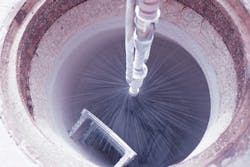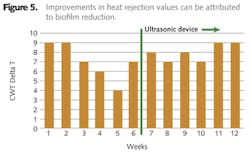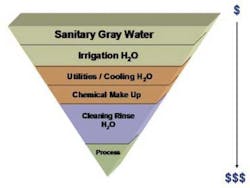From the early days of trying to overcome water challenges, Singapore has turned a vulnerability into a strategic asset. So how does one the world's leading nations expect to stay ahead of the field? Michael Toh looks at how the country plans to advance its water supply network, including an update on its second desalination facility and planned use of bio-mimicry technology.
Adensely populated island city state with more than five million people in a land area of about 700 square kilometres, Singapore's main water challenges stem from a lack of natural aquifers and groundwater and land to collect and store rainwater. Not naturally endowed with an abundance of land or water, Singapore had to rely heavily on water from local catchments and imported water as its main water sources for more than 40 years.
Today it is capable of producing all the water that its industries and population require. By investing in water R&D and adopting an integrated approach to water management in the last 40 years, PUB has put in place a robust, diversified and sustainable water supply system, known as the Four National Taps -- water from local catchment, imported water, desalinated water, and NEWater, its own brand of high-grade reclaimed water.
Through integrated water management, PUB, Singapore's national water agency, has successfully closed the "water loop" and manages the whole water cycle, from rainwater collection to the purification and supply of drinking water, to the treatment of used water and its reclamation into NEWater.
Although the country is already at the forefront of water management technology, its recognition of future challenges has meant that it is continually investing in R&D, infrastructure development and engaging the community to address future water demands.
Future Water Demands
Today, water demand in Singapore is about 380 million gallons a day (mgd), with 45% coming from the domestic sector and the rest from the non-domestic sector. By 2060, water demand is expected to double from the current levels, with about 70% of the demand coming from the non-domestic sector and the rest from the domestic sector. Singapore plans to ramp up desalination plant capacity by 10 times to meet 30% respectively of the water demand.
Following Singapore opening its first desalination plant in 2005, a second desalination plant to be built by Hyflux will commence operations in 2013. However, desalination is currently the most energy intensive water supply source.
Singapore has been investing in R&D to uncover more resource-efficient ways to produce desalinated water. With the aim of at least halving the current energy consumption levels, PUB has partnered Siemens Water Technologies to experiment with electrically-driven processes to desalt seawater.
Another R&D project, with Keppel Seghers to develop the Memstill® technology, uses waste heat to produce drinking water from seawater. This process can reduce the energy needed for seawater desalination to a third of the current value. In the longer term, PUB is exploring bio-mimicry for desalination. Drawing inspiration from nature and emulating its elements, processes and systems, novel engineering solutions that challenge existing technological paradigms can potentially be derived. In line with plans to boost Singapore's desalination capacity by almost 10 times to meet about 30% of future water demand, five sites have already been identified for future desalination plants.
Urban planning and wastewater
Urban planning and infrastructure development play a significant role in the efficient collection and distribution of water. Anticipating challenges early provides for more options downstream.
For instance, developing separate collection systems for used water and rainwater at the outset has allowed Singapore to integrate the drainage system and channel rainwater to its reservoirs without affecting water quality. Separately, the used water network could be optimally designed independent of rainfall, thus optimising land use and minimising the risks of sewage overflow. These are especially relevant to Singapore since it is a highly urbanised city.
Since 2009, almost half the island's used water system has been connected with a newly-completed Deep Tunnel Sewerage System (DTSS). When the second phase is completed by 2030, this uniquely designed system will be able to meet Singapore's water collection, treatment and disposal needs for the next century.
This intricate network is located up to 55 meters below ground level and currently stretches from the northern to the western points of Singapore. This is an example of integrated urban planning that took a decade to plan, design and construct.
Increased recycled water
The country also plans to triple its NEWater capacity to supply 50% of demand by 2060. Introduced in 2003, NEWater or recycled water is produced using advanced membrane technologies and has been vetted by more than 65,000 scientific tests, surpassing even the World Health Organisation standards for drinking water. It is supplied primarily for non-domestic use in wafer fabrication parks, industrial estates and commercial buildings, where it is used for industrial and air-cooling purposes. A small percentage is mixed with raw reservoir water before being treated as drinking water.
Singapore's experience with NEWater has demonstrated that water reuse is a cost-effective and sustainable solution to the global water challenge. By allowing every drop of water to be used and re-used, the cycle can go on indefinitely, thereby multiplying the water supply many times over. It is also a more reliable source of water supply than conventional water sources which rely mostly on rain.
With more than half the world's population living in cities, and increasing urbanisation, there is great potential for water recycling to be harnessed as a sustainable water solution for cities around the world.
Expanding water sources further
With all the major estuaries already dammed to create reservoirs in Singapore, due to a lack of natural aquifers and lakes, the next step is to tap minor catchments. This is made possible with the Variable Salinity Plant, a technology PUB pioneered to harness water from the remaining streams and rivulets near the shoreline. Integrating desalination and NEWater treatment processes to treat water of varying salinity into potable water, this technology has the potential to increase its water catchment from two-third to 90% of Singapore's land area.
water catchment enjoyment
Singapore recognises that water sustainability cannot be achieved through increasing the water supply alone. It is equally important to manage the demand side through partnership with different stakeholders. PUB encourages the community to see themselves as joint stewards of water.
This is especially so given that two thirds of Singapore is water catchment so most people live, work and play in water catchments, including downtown Singapore where all the rain collected flows into the Marina reservoir created by the Marina Barrage.
The idea is that they should enjoy the reservoirs and waterways, but to also see that they have to play a part in helping to keep the water clean. Singapore has therefore embarked on an Active, Beautiful, Clean Waters (ABC Waters) programme to transform its waterways and reservoirs beyond their utilitarian functions into hotspots for recreational and community activities.
Water as an economic asset
Beyond managing water as a resource and an environmental asset, Singapore has also turned it into an economic asset. The government, through the Environment and Water Industry Programme Office (EWI), pledged S$330 million in 2006 to develop Singapore into a global hydrohub through investments in R&D. A water research eco-system with 21 research centres undertaking projects in various domains like membrane, bio-mimicry and low energy seawater desalination have been spawned. WWi
Author's note:Michael Toh is the managing director of the Singapore International Water Week. He is concurrently the senior deputy director of the Industry Development Department at PUB, Singapore's national water agency.
The fourth Singapore International Water Week will be held from 4-8 July 2011 with the theme of Sustainable Water Solutions for a Changing Urban Environment. Email: [email protected]
More Water & WasteWater International Current Issue Articles
More Water & WasteWater International Archives Issue Articles






